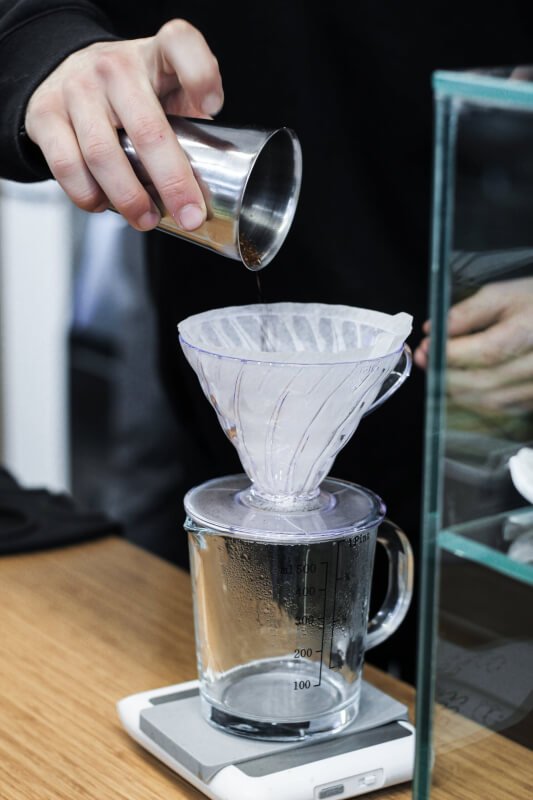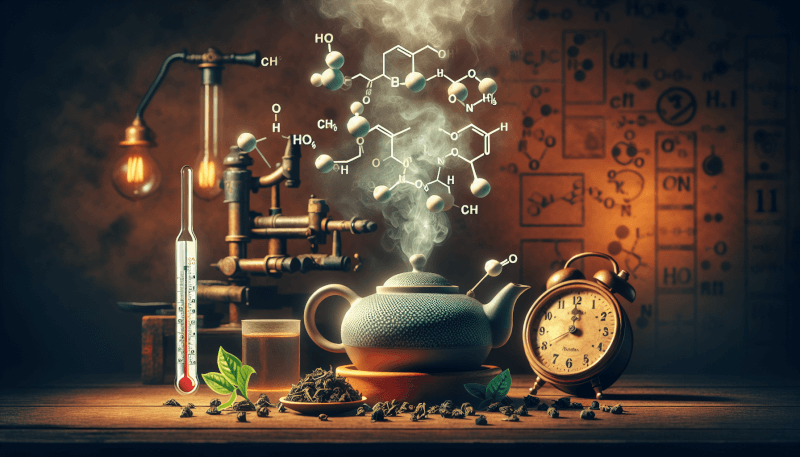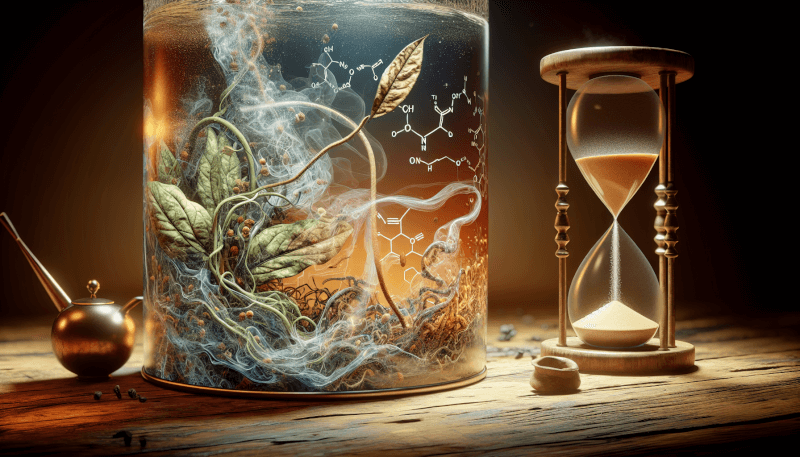Tea brewing is not just a simple process of adding hot water to tea leaves; it is a fascinating science that involves a careful balance of time, temperature, and technique. In this article, you will gain a deeper understanding of the intricate science behind tea brewing. From the chemical reactions that occur during steeping to the influence of water quality on flavor extraction, we will explore the captivating world of tea and uncover the secrets to achieving the perfect cup. So, grab your favorite mug and prepare to deepen your appreciation for the art of tea brewing.

The Chemistry of Tea Leaves
Tea leaves are composed of various chemical compounds that contribute to their taste, aroma, and health benefits. These compounds include polyphenols, amino acids, volatile oils, and pigments. The composition of tea leaves depends on factors such as the type of tea plant, growing conditions, and processing methods.
Composition of Tea Leaves
Tea leaves contain a high concentration of polyphenols, particularly catechins, which are powerful antioxidants. These polyphenols give tea its characteristic bitterness and astringency. The amino acid L-theanine is also found in tea leaves, which contributes to its unique flavor profile and has relaxing and mood-enhancing effects. Volatile oils, such as the aromatic compound linalool, give tea its aroma. Pigments like chlorophyll and anthocyanins contribute to the color of tea leaves. Understanding the composition of tea leaves is crucial in understanding the chemical changes that occur during tea processing and brewing.
Biochemical Changes during Tea Processing
Tea processing involves a series of biochemical changes that transform freshly harvested tea leaves into the final product. The two main processes are oxidation and drying. During oxidation, enzymes in the tea leaves interact with oxygen, leading to the browning of the leaves and the development of complex flavors. The degree of oxidation determines the type of tea produced, such as green, black, or oolong tea. Drying is then done to halt the oxidation process and preserve the desired flavor compounds. Understanding these biochemical changes is essential for achieving the desired taste and aroma in the final cup of tea.
Chemical Reactions during Brewing
When tea leaves are brewed in hot water, various chemical reactions occur that further contribute to the flavor and aroma of the tea. The main reactions include extraction, diffusion, oxidation, and enzymatic reactions. Extraction involves the dissolution of soluble compounds, such as polyphenols and caffeine, from the tea leaves into the water. Diffusion allows the flavor components to move from the tea leaves to the surrounding water, enhancing the taste and aroma. Oxidation and enzymatic reactions continue to occur during brewing, further influencing the flavor profile. Understanding these chemical reactions is crucial in brewing a perfect cup of tea.
Factors Affecting Tea Extraction
Several factors play a role in the extraction of compounds from tea leaves during brewing. These factors include temperature, time, water quality, leaf-to-water ratio, and agitation. Understanding how each of these factors affects tea extraction can help you optimize the brewing process and enhance the flavor and health benefits of your tea.
Temperature
Temperature is a critical factor in tea extraction. The temperature of the water used for brewing determines which compounds are extracted and influences the overall flavor profile. Different compounds have different solubilities at different temperatures. For example, higher temperatures enhance the extraction of catechins, while lower temperatures preserve more delicate flavors. Finding the right temperature for each type of tea is essential for achieving the desired taste.
Time
The duration of brewing also affects tea extraction. The longer the tea is steeped, the more compounds are extracted, which can lead to a stronger and more intense flavor. However, brewing for too long can result in overextraction and bitterness. Finding the optimal brewing time for your specific tea variety is crucial to strike the right balance of flavor.
Water Quality
The quality of water used for brewing tea can significantly impact the flavor. Water composition, including mineral content, pH level, and hardness, influences the extraction of compounds from tea leaves. Hard water, for example, can reduce the extraction of flavor compounds, while soft water may result in a milder taste. Experimenting with different types of water can help you find the optimal water quality for your preferred cup of tea.
Leaf-to-Water Ratio
The ratio of tea leaves to water used in brewing also affects the overall flavor and strength of the tea. A higher leaf-to-water ratio will result in a more concentrated and intense brew, while a lower ratio will produce a milder taste. Finding the right balance depends on personal preference and the type of tea being brewed.
Agitation
Agitating the tea leaves during brewing can enhance the extraction of compounds. Stirring or swirling the tea can help distribute the flavors more evenly and extract the desired compounds. However, excessive agitation can result in a cloudy appearance or bitter taste. Experimenting with different agitation techniques can help you find the optimal balance for your tea brewing process.
Role of Temperature in Tea Brewing
Temperature plays a crucial role in tea brewing, influencing the solubility of compounds, flavor extraction, and the overall taste of the tea.
Solubility of Compounds in Tea
Different compounds in tea have varying solubilities at different temperatures. Catechins, which are responsible for the antioxidant properties of tea, have higher solubility at higher temperatures. This means that brewing tea at higher temperatures will result in greater extraction of catechins. On the other hand, the amino acid L-theanine, which contributes to the relaxing effects of tea, has lower solubility at higher temperatures. Therefore, brewing at lower temperatures preserves more L-theanine.
Impact on Flavor Extraction
Temperature also affects the extraction of flavor compounds in tea. Some compounds, such as volatile oils, are more easily extracted at higher temperatures, resulting in a more aromatic and flavorful cup of tea. However, excessive heat can lead to the loss of delicate flavors. Finding the optimal temperature for each type of tea is essential to achieve a well-balanced and flavorful brew.
Effects on Tannin Extraction
Tannins are compounds that contribute to the astringency and bitterness of tea. Higher temperatures generally lead to increased extraction of tannins, resulting in a more astringent and bitter taste. If you prefer a milder and less astringent tea, brewing at lower temperatures can help reduce the extraction of tannins.
Bitterness and Astringency
Bitterness and astringency are common characteristics of tea. While some people enjoy the robust and bitter flavors, others may find it unpleasant. The bitterness in tea is due to the presence of caffeine and tannins, while astringency is caused by the interaction of tannins with proteins in the mouth. Adjusting the brewing temperature can help control the intensity of bitterness and astringency, allowing you to tailor your tea to your taste preferences.
Importance of Brewing Time
The brewing time of tea plays a significant role in the extraction of compounds, flavor development, and overall taste. Understanding the optimal brewing time for different types of tea is essential for achieving the desired flavor profile.
Extraction of Caffeine and Other Stimulants
The brewing time directly affects the extraction of caffeine and other stimulants from tea leaves. Caffeine is one of the compounds responsible for the energizing effects of tea. Brewing for a longer time will result in a higher extraction of caffeine, leading to a more stimulating cup of tea. However, if you prefer a milder tea with less caffeine, reducing the brewing time can help achieve that.
Flavor Development
The duration of brewing also influences the development of flavors in tea. Different flavors are released at different stages of brewing. Shorter brewing times may result in a milder and subtler taste, while longer brewing times can enhance the richness and complexity of flavors. Experimenting with brewing times can help you discover the flavor profile that suits your preferences.
Tannin Accumulation
Brewing tea for an extended period can lead to the accumulation of tannins, which contribute to the astringency and bitterness of the tea. If you prefer a milder and less astringent brew, reducing the brewing time can help mitigate the extraction of tannins.
Brewing Time for Different Types of Tea
Different types of tea require different brewing times to achieve the desired taste. For example, delicate green teas are often brewed for a shorter time, typically around two to three minutes, to preserve their delicate flavors. In contrast, black teas are typically brewed for a longer time, around four to five minutes, to extract their robust and bold flavors. Understanding the recommended brewing time for each type of tea can help you achieve the best flavor experience.

Water Quality for Optimal Brewing
The quality of water used for brewing tea significantly impacts the taste and overall quality of the final cup. Understanding the importance of water composition, pH level, and hardness can help you optimize the brewing process.
Impact of Water Composition on Tea Extraction
The mineral content and composition of water can influence the extraction of compounds from tea leaves. Water with high mineral content, such as hard water, can reduce the extraction of flavor compounds and result in a flat-tasting cup of tea. On the other hand, soft water can enhance the extraction of flavors and result in a more rounded and flavorful brew. Experimenting with different types of water can help you find the optimal composition for your preferred tea.
Role of pH in Tea Brewing
The pH level of water also affects the extraction of compounds from tea leaves. Different compounds have different solubilities at different pH levels. Generally, more acidic water enhances the extraction of catechins, while higher pH levels favor the extraction of aromatic compounds. Finding the right pH balance can help you achieve a well-balanced and flavorful cup of tea.
Hardness and Softness of Water
Water hardness refers to the amount of minerals, such as calcium and magnesium, present in the water. Hard water can negatively affect the taste and appearance of tea, as it can lead to the formation of a scum or residue. Soft water, on the other hand, can result in a milder and cleaner-tasting tea. Understanding the hardness of your water can help you make adjustments or choose alternative water sources to optimize the brewing process.
Filtered vs. Tap Water
The choice between filtered and tap water can also impact the quality of your brewed tea. Tap water often contains chlorine or other chemicals that can affect the flavor and aroma. Using filtered water can help remove these impurities and result in a cleaner and purer-tasting cup of tea. However, if your tap water is of high quality and does not have any noticeable taste or odor, it may be suitable for brewing tea.
Leaf-to-Water Ratio
The ratio of tea leaves to water used in brewing affects the flavor intensity, caffeine content, and overall strength of the tea. Finding the right leaf-to-water ratio is crucial to achieving the desired taste.
Effects on Flavor Intensity
Increasing the leaf-to-water ratio will result in a more concentrated and intense flavor. The higher the ratio, the stronger and bolder the tea will taste. This can be desirable for those who prefer a robust and full-bodied cup of tea. However, excessive amounts of tea leaves can also lead to a bitter or astringent taste. Finding the right balance of flavor intensity is a matter of personal preference.
Influence on Caffeine Content
The leaf-to-water ratio directly affects the caffeine content of the brewed tea. Using a higher ratio of tea leaves will result in a higher concentration of caffeine. If you prefer a milder brew with less caffeine, reducing the amount of tea leaves can help achieve that.
Tea Strength and Concentration
The leaf-to-water ratio determines the overall strength and concentration of the tea. A higher ratio will result in a stronger brew, while a lower ratio will produce a milder taste. Adjusting the leaf-to-water ratio can help you find the perfect balance for your preferred tea strength.
Finding the Right Ratio
Finding the right leaf-to-water ratio depends on personal preference, the type of tea, and the desired strength of the brew. Experimenting with different ratios can help you discover the perfect balance for your taste buds.

The Science of Steeping
Steeping is the process of infusing tea leaves in hot water, allowing the extraction of compounds and the development of flavors. Understanding the science behind steeping can help you master the art of brewing tea.
Dissolution of Soluble Compounds
When tea leaves are steeped in hot water, soluble compounds such as catechins, caffeine, and volatile oils are dissolved and extracted from the leaves. The extraction occurs through the breaking of chemical bonds between the compounds and the matrix of the tea leaves. The duration of steeping determines the extent of this dissolution process.
Diffusion of Flavor Components
During steeping, flavor components in the tea leaves diffuse into the surrounding water. This diffusion allows the flavors to spread and disperse, resulting in a well-rounded taste. The rate of diffusion is influenced by factors such as temperature, agitation, and surface area of the tea leaves.
Oxidation and Enzymatic Reactions
Steeping also involves oxidation and enzymatic reactions. Oxidation occurs due to the exposure of tea leaves to oxygen in the air, leading to the browning of the leaves and the development of complex flavors. Enzymes present in the tea leaves facilitate these oxidation reactions. Controlling the duration of steeping is crucial to achieving the desired level of oxidation and flavor development.
Physical Changes in Tea Leaves
Steeping causes physical changes in tea leaves, including the expansion and unfurling of the leaves. This expansion increases the surface area exposed to the water, allowing for greater extraction of compounds and flavors. The visual appearance of the tea leaves can also change during steeping, reflecting the release of color pigments and the dissolution of compounds.
Understanding the Role of Agitation
Agitation, or stirring, during tea brewing can affect the extraction of compounds, flavor release, and the appearance of the final cup. Properly understanding the role of agitation is crucial in controlling the brewing process.
Enhancement of Extraction
Agitating the tea leaves during brewing increases the contact between the leaves and the water, enhancing the extraction of compounds. Stirring helps to break down the protective layer on the surface of the tea leaves, enabling greater access to the flavor compounds inside. This increased contact allows for a more thorough extraction of flavors, resulting in a fuller taste.
Impact on Flavor Release
Agitation facilitates the release of flavors from the tea leaves. Stirring creates movement and disperses the flavor components throughout the water, allowing for a more even distribution of flavors. This process can enhance the complexity and depth of the taste in the final cup of tea.
Effects on Tea’s Color and Appearance
Agitating the tea leaves during brewing can affect the color and appearance of the brewed tea. Stirring can lead to a more intense color as the color pigments in the tea leaves are released more efficiently. Additionally, agitation can create a foamy or frothy appearance on the surface of the tea. This can contribute to the visual appeal of the tea.
Agitation Techniques
There are various techniques for agitating tea leaves during brewing. Stirring with a spoon, using a specialized tea infuser with a built-in agitator, or gently shaking the teapot are popular agitation methods. The intensity and duration of agitation can vary depending on personal preference and the desired outcome. Experimenting with different agitation techniques can help you find the right balance for your tea brewing process.

Effects of Tea Brewing on Health Benefits
Brewing tea not only creates a flavorful beverage but also unlocks its potential health benefits. Understanding the effects of tea brewing on the extraction of antioxidants and other bioactive compounds can help you optimize your tea-drinking experience.
Antioxidant Content
Tea is rich in antioxidants, which help protect the body against free radicals and oxidative stress. The brewing process plays a crucial role in extracting these antioxidants, particularly catechins. The duration and temperature of brewing can influence the amount of antioxidants extracted, with higher temperatures and longer brewing times resulting in increased antioxidant content.
Polyphenol Extraction
Polyphenols are a class of compounds found in tea that have numerous health benefits. These compounds contribute to the antioxidant activity of tea and may have anti-inflammatory and anti-cancer properties. The brewing process allows for the extraction of polyphenols, with longer steeping times leading to higher levels of polyphenol content. However, it is important to note that excessive brewing times can also lead to the extraction of bitter and astringent compounds, which may reduce the overall enjoyment of the tea.
Catechins and EGCG
Catechins, a type of polyphenol, are particularly abundant in green tea and are known for their potent antioxidant properties. Epigallocatechin gallate (EGCG), one of the catechins, has been studied for its potential health benefits, including its role in weight management and cardiovascular health. Brewing green tea at lower temperatures and for shorter durations can help preserve the levels of catechins and EGCG.
Optimizing Health Benefits
To optimize the health benefits of tea, it is important to consider factors such as brewing temperature, steeping time, and the type of tea being brewed. Experimenting with different brewing parameters can help you find the optimal conditions for maximizing the extraction of beneficial compounds. It is also advisable to choose high-quality tea leaves and brew them properly to enhance the overall health benefits.
Tips and Tricks for Better Tea Brewing
To improve your tea brewing skills and elevate your tea-drinking experience, consider these tips and tricks:
Water Temperature Control
Invest in a reliable and accurate tea thermometer to ensure that you brew your tea at the correct temperature. Different types of tea require different water temperatures, so it is essential to have precise control. Avoid using boiling water for delicate teas, as it can scorch the leaves and result in a bitter taste.
Experimenting with Brewing Time
Explore different steeping times to discover the optimal duration for your preferred tea. Start with the recommended brewing time and gradually adjust it according to your taste preferences. Keep in mind that certain teas may become bitter if oversteeped, so be mindful of the brewing time to avoid any unpleasant flavors.
Understanding Tea Varieties
Each type of tea has its own unique characteristics and brewing requirements. Familiarize yourself with different tea varieties, such as green, black, oolong, and herbal teas, to understand their flavor profiles and the best brewing techniques. This knowledge will help you appreciate the nuances of each tea and brew them to perfection.
Exploring Different Infusion Methods
Experiment with different infusion methods to add variety to your tea-drinking experience. Consider using a teapot, a gaiwan, a tea infuser, or even a French press to brew your tea. Each method can yield different flavors and aromas, allowing you to discover new dimensions of tea enjoyment.
Proper Storage of Tea Leaves
To ensure the freshness and quality of your tea, store it properly. Keep it in an airtight container away from light, heat, and moisture. Avoid storing tea near strong-smelling substances, as tea leaves can absorb odors easily. By storing your tea correctly, you can preserve its flavor and aroma for a longer period.
In conclusion, understanding the science behind tea brewing is vital in creating the perfect cup of tea. Factors such as temperature, time, water quality, leaf-to-water ratio, and agitation all play significant roles in extracting the desired compounds and flavors from tea leaves. By mastering these factors and experimenting with different brewing techniques, you can optimize the brewing process to achieve the ideal taste and enjoy the health benefits of tea. So, grab your favorite tea leaves, follow the guidelines, and embark on a flavorful journey. Cheers to the art and chemistry of tea brewing!



